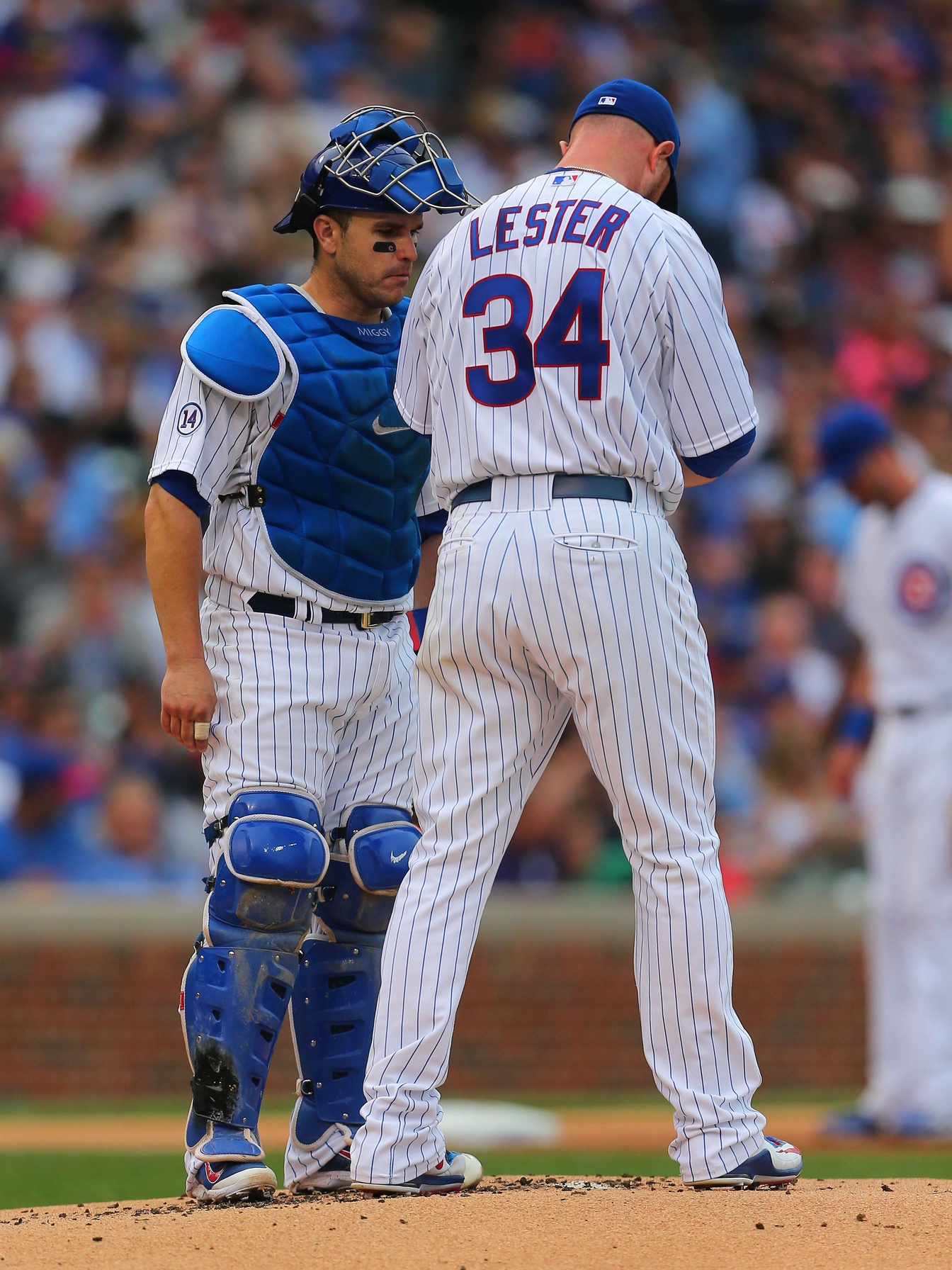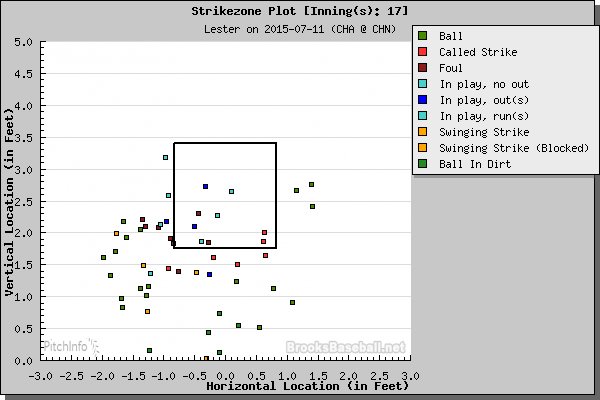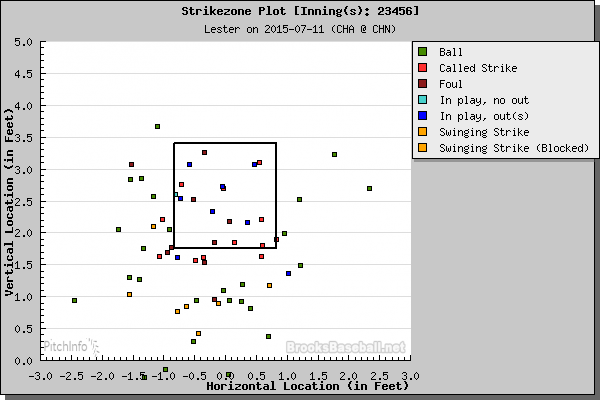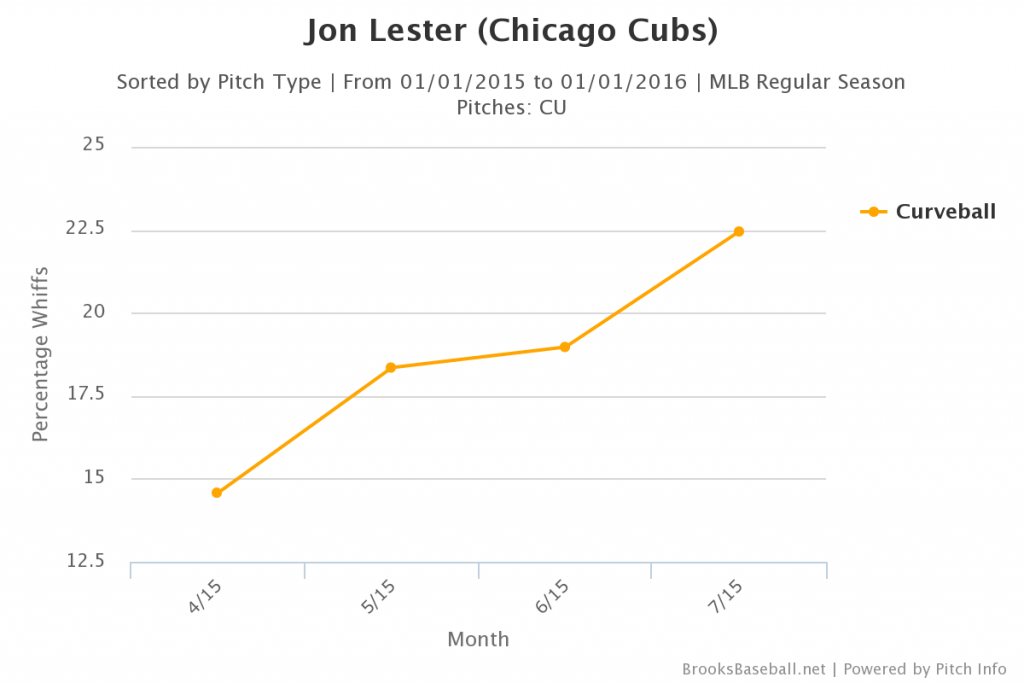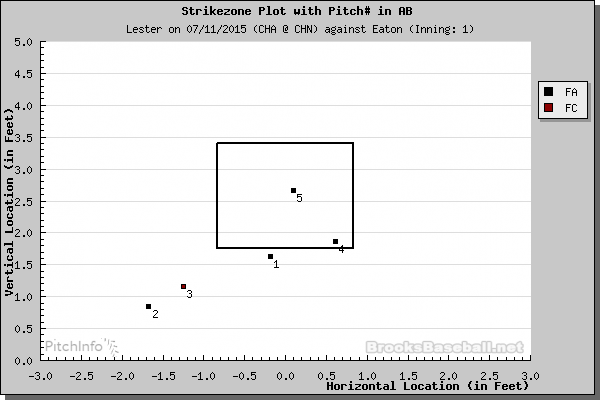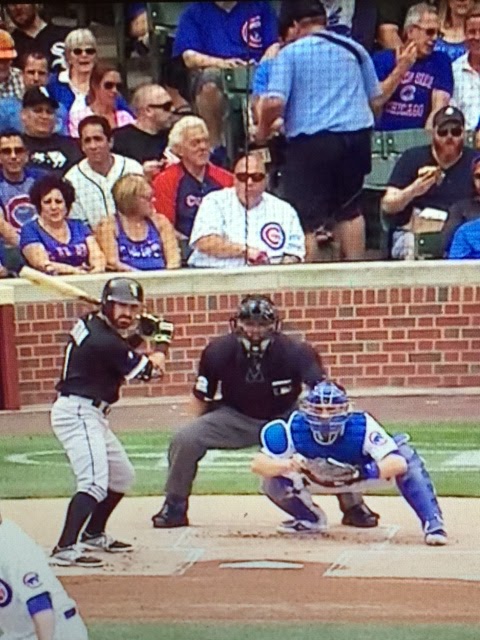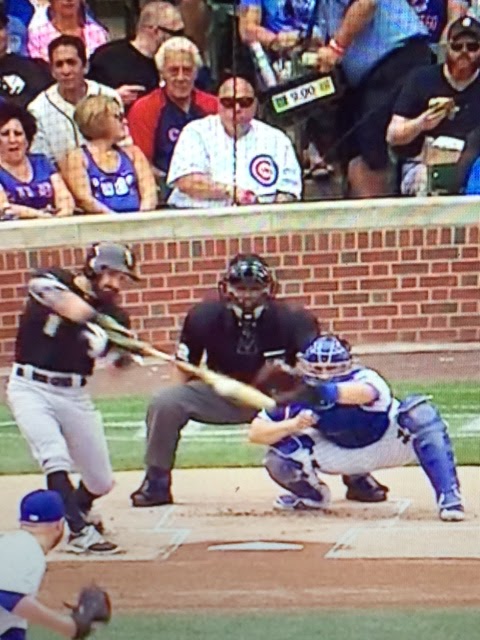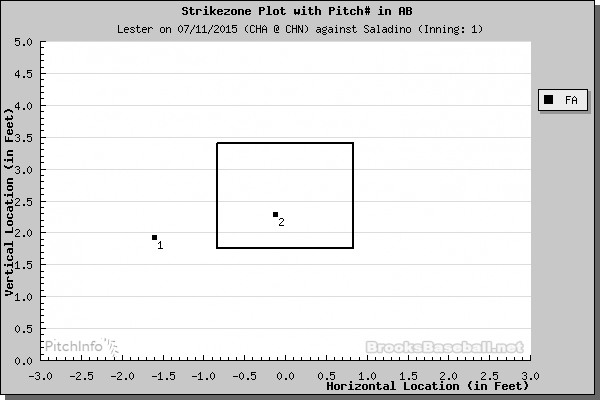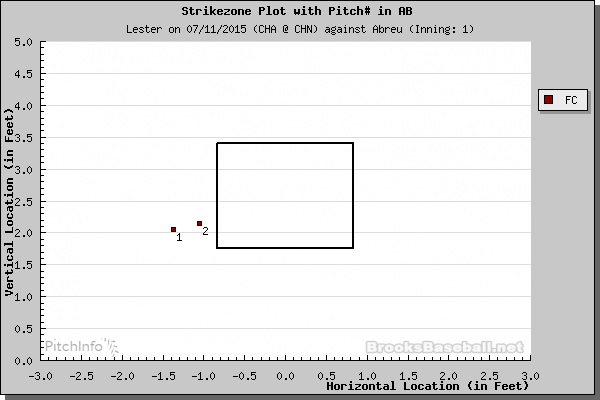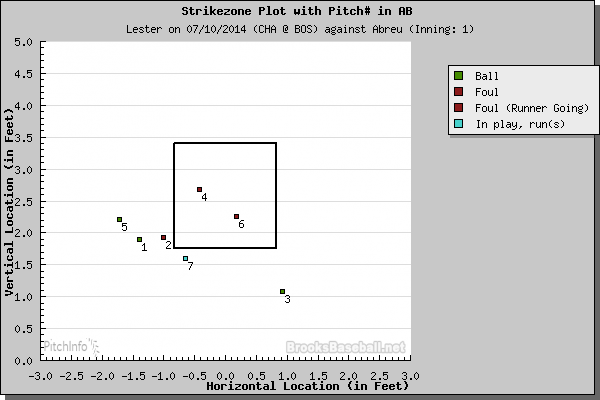Date: July 11
Opponent: Chicago White Sox
Location: Wrigley Field
Introduction
Typically, I open the Ballad with a remark so witty or a pop culture reference so inspired that it likely causes my reader to say, “I try to be a supportive dad, Andrew, but there’s limits.” In the final Ballad of the season’s first half though, I am instead opening with a remarkable statistic:
Entering Saturday, the Chicago White Sox had one player with a slugging percentage above .386. One! It was Jose Abreu, who with a .495 slugging percentage had no teammate within 100 points.
It was this type of offensive ineptness that led me to Tweet the following before the game:
Good news for #Lester and @Cubs : #WhiteSox vs. LHP: .226/.270/.308, 8 HR, 5.2% BB, 22.4% K @BPWrigleyville @sahadevsharma
— Andrew Felper (@AndrewFelper) July 11, 2015
I’m sorry, Wrigleyvillers.
No matter how you look at it, Jon Lester’s start against the Chicago White Sox was disappointing. Lester threw his fewest strikes of the season (57.8 percent), even though he did not issue a walk. He did generate eleven whiffs on pitches outside the strike zone, but not a single whiff on a pitch inside the strike zone. Lester got ahead of just 53.6 percent of batters (15 of 28). All seven hits he gave up came on fastballs. In the first and seventh innings, when the White Sox won the game, Lester was rendered almost entirely ineffective when he came near the strike zone:
That was in stark contrast to innings two through six, when Lester was able to induce whiffs and outs in the strike zone:
In fact, Lester was downright effective in between the first and seventh innings:
| Pitches | Baserunners | R (ER) | |
| Innings 1 and 7 | 53 | 6 | 5 (4) |
| Innings 2-6 | 63 | 1 | 0 |
His curveball and changeup were outstanding, combined accounting for six of his eight strikeouts (see Pitch Breakdown section). The damage that bookended Lester’s start, though, would be too much to overcome.
At this point in the Ballad, it has been customary to discuss the opponent’s offensive prowess, or lack thereof (“Top five in the NL in….”, “Bottom three in the league in…”). With the White Sox, however, we can just state it definitively: They are the worst. Overall, the team has the AL’s worst OPS (.653), ISO (.115), fly-ball rate (29.0 percent), and the fewest doubles (119) and home runs (60). As a team, the White Sox are shockingly inept against left-handed pitchers, hitting just .226/.270/.308. Against left-handers, they have not hit for power (eight home runs), drawn walks (5.2 percent walk rate), or even really put the ball in play (22.4 percent strikeout rate).
In his final start before the All-Star break, Lester was roughed up by the worst offense in the AL. We can’t dress that up. Muster the energy to read below for a final breakdown before we get back to real baseball after some much-needed downtime.
Traditional Line
7.0 IP, 7 H, 8 K, 0 BB, 5 R (4 ER)
Pitch Breakdown
116 pitches (67 strikes)
| Total | Velocity (Max) | AVG | SLG | BABIP | |
| Four-Seam | 34 | 92.2 (93.7) | .276 | .543 | .300 |
| Cutter | 38 | 89.1 (91.4) | .250 | .250 | .286 |
| Sinker | 14 | 91.0 (92.5) | 1.000 | 1.500 | 1.000 |
| Changeup | 11 | 84.3 (86.2) | .000 | .000 | .000 |
| Curveball | 19 | 75.0 (77.8) | .000 | .000 | .000 |
Lester went to his four-seam fastball a season low 29.3 percent (34 of 116 pitches). Astoundingly, Lester did not generate a single whiff on his four-seam fastball. Adam Eaton’s leadoff double (see Key At-Bat/Sequence section) was the sixth extra-base hit he has surrendered to left-handed batters off his four-seam fastball, which is just two fewer than he gave up in all of 2014. In the first half of the season, his average velocity with his four-seam fastball is 92.77, down from 93.01 in 2014, which was down from 93.76 in 2013.
Lester threw more cutters than four-seamers for the second time in three starts, and just the third time this season. He did not surrender any extra-base hits off the pitch, but he did give up an RBI single to Jose Abreu in the first inning, which was a curious pitch selection based on their brief history (see Key-At Bat/Sequence section).
It was only fitting that in Lester’s final start of the half his curveball was his best pitch, as it has been his best pitch throughout 2015. Of his eight strikeouts, five came via the curve. Throughout the season, we have detailed how Lester’s fastballs and curve work in tandem, with him at his best when the former is used to set-up the latter. Against the White Sox, however, the curve was used to set-up the changeup, a pitch Lester went to a season high 9.5 percent of all pitches on Saturday (11 of 116). Two of Lester’s strikeouts came on changeups that had been set-up by curveballs the previous pitch.
At the break, Lester has gone to his curve 15.7 percent of all pitches, with opposing batters hitting just .153/.167/.254 with a 48.3 percent strikeout rate. As the season has progressed, Lester’s whiff percentage off his curve has increased steadily:
It took Lester and Ross more than a month to involve his curve (just 12.8 percent usage in his first five starts), but it has been his best pitch, both on Saturday and throughout the first three plus months.
Trends
When the story is written of the first half of Lester’s 2015, after they cover the onset of my Stockholm Syndrome and subsequent deprogramming, the first chapter will undoubtedly be titled ‘Missed Locations with Four-Seam and Cut Fastballs.’ Saturday’s start against the White Sox was just the latest addition to what has become a never-ending chapter.
In 2014, Lester threw his four-seamer and cutter a combined 73.2 percent of all pitches:
| Frequency | K% | BB% | AVG | SLP | BABIP | |
| Four-Seam | 42.4% | 19.3% | 7.7% | .248 | .390 | .289 |
| Cutter | 30.8% | 26.9% | 6.2% | .234 | .367 | .307 |
In 2015, Lester has gone to the two pitches with slightly less frequency, but has increased his strikeout rate. The results, though, have not been quite the same:
| Frequency | K% | BB% | AVG | SLP | BABIP | |
| Four-Seam | 40.1% | 24.1% | 9.5% | .277 | .487 | .340 |
| Cutter | 28.3% | 23.2% | 7.3% | .286 | .444 | .363 |
So, what has changed from one season to the next? Obviously, the BABIP for both pitches is significantly higher than a season ago. He is also above his career BABIP for both the four-seamer (.306) and cutter (.336) entering the season.
The biggest difference, though, has been Lester’s struggle to consistently locate and execute with his two most prominent pitches. Against the White Sox, that was evident from the first inning (again, see Key-At Bat/Sequence section), when all three hits came on four-seamers and cutters.
In May, we detailed Lester’s sudden penchant for surrendering home runs off his four-seamer and cutter. Lester surrendered eight home runs in six starts, all off four-seam and cut fastballs that missed their spots. To compensate, as we chronicled in June, David Ross spent multiple starts setting up with his foot inside the batter’s box, with his glove more than six inches off the plate. As we wrote after it proved successful against the Minnesota Twins on June 20:
During last Sunday night’s start against Cincinnati, it was clear from the outset that Lester and David Ross were attempting to attack his biggest problem in 2015 by setting up further off the plate, or “right under the batter’s armpit” as Curt Schilling noted during the first inning. The positioning of Ross had an explicit message: “If you’re going to miss, miss in here,” said John Kruk, noted member of the Alpha Betas from Adams College.
If Lester is to find a rhythm in the season’s second half it will be because he is able to locate his four-seam and cut fastballs.
Key At-Bat/Sequence
Inning: First Inning
Score: 0-0
Situation: Adam Eaton leading off the game
Batter(s): Adam Eaton, Tyler Saladino, Jose Abreu
Speaking of fastballs, as we have for thousands of words through eighteen starts, the game’s opening three batters jumped on four-seamers and cutters to give the White Sox an early lead that would prove the difference in the game.
Chicago’s lead-off batter, Adam Eaton, entered the game hitting .248/.312/.386, which still placed him among the team’s top offensive threats. For the first four pitches, Lester and Montero attacked him with four-seamers and cutters low and/or away:
On 2-2, Montero again set-up low and away:
Lester, however, missed up and over the plate with a 93 mph four-seamer:
Eaton jumped on the flat fastball over the heart of the plate for a double to left-center field. Despite his struggles in 2015, he entered hitting .343/.500/.412 against four-seam fastballs from left-handed pitchers in his career.
With Eaton standing on second base, rookie third baseman Tyler Saladino stepped to the plate. Saladino had made his major-league debut on Friday, and Kyle Hendricks attacked him with sinkers (nine of 13 pitches) and induced three groundouts. Entering Saturday, right-handed batters were slugging just .302 against Lester’s sinker. However, Lester and Montero elected to go after Saladino with four-seam fastballs:
On 1-0, Lester missed his spot with a 92 mph four-seamer down the middle, and Saladino lined it into the right-field gap for an RBI triple and his first career hit. It was a bad pitch, both in terms of selection and execution.
With the runner on third, the Cubs played the infield in. Lester missed inside with a cut fastball to fall behind 1-0, and came back inside with a cutter:
While Lester hit his spot, Abreu was able to bounce it back up the middle to give the White Sox a quick 1-0 lead. Abreu entered the game 3-for-6 against Lester. On July 10, 2014, in their first matchup, Lester tried to come inside on a full count with an 89 mph cutter:
Abreu ripped a double off the Green Monster. Going forward, Lester might think twice about trying to come inside to Abreu with cutters.
Lester entered the break still struggling to consistently locate his four-seam and cut fastballs. He would settle down after the first inning, but the White Sox had taken advantage of fastballs left up and over the plate.
Keep-In-Mind
A special, mid-season, three-part KIM © section. You’re welcome, America:
2013: Lester has been here before. His 2013 season was defined by his performance before and after the All-Star break:
| Starts | ERA | WHIP | OPS | BABIP | K% | HR | |
| Before ASG | 20 | 4.58 | 1.369 | .745 | .303 | 18.6% | 15 |
| After ASG | 13 | 2.57 | 1.186 | .642 | .298 | 20.3% | 4 |
At the 2013 All-Star break, he was just coming out of a slump that had lasted since September 2011. He would finish that season being mentioned among the greatest postseason pitchers of all time. And like with 2015, he was struggling with his fastballs. As we wrote last month:
In the Introduction section we mentioned Lester’s four-seamer struggles during his brutal 37-start stretch in 2011 and 2012. During that stretch, he was throwing his four-seam fastball just 36 percent of the time, as against the pitch opposing batters hit .312/.404/.598 with 18 home runs. With his four-seamer, his strikeout rate (15.0 percent) and walk rate (13.4 percent) were nearly identical).
Starting in 2013, though, and carrying through the 2014 season, his four-seamer returned to prior effectiveness, as he threw it 43.5 percent of the time, and held opposing batters to .241/.317/.368. His strikeout rate was (18.2 percent) was nearly double his walk rate (10.0 percent). The point is, Lester has struggled through much longer, prolonged stretches without his best four-seamer, and he came back strong with the pitch.
Coaching Changes: Lester is working with his seventh pitching coach in six seasons, thanks to the fallout of the Red Sox 2011 and 2012 seasons, and his trade to Oakland at last season’s deadline. Chris Bosio has already earned a reputation as a stellar pitching coach. Let’s give him and Lester some more time to build a relationship and adjust.
Run Support: We have gone to this well multiple times for the KIM © section, but Lester has had little margin for error. At 2.61 runs per game, Lester has received the lowest run support of any pitcher in the NL. In nine of 18 Lester starts, the Cubs have scored zero or one run. Anthony Rizzo has done his best to provide Lester with run support, hitting .338/.430/.544 with three home runs and a 14 percent walk rate. Kris Bryant, though, has hit just .246/.358/.351 with a 29.9 percent strikeout rate. Even when Lester has been sharp, the Cubs offense has done little to support their no. 1 starter.
Conclusion
We dissected and dismembered Saturday’s start enough, so this Conclusion section will wrap-up the Good and Not-So-Good of Jon Lester’s first half-season with the Chicago Cubs:
The Good: Lester has 11 quality starts, the same total as Johnny Cueto and Michael Wacha, and just two fewer than Jacob deGrom and Max Scherzer. At times, like the entire month of May, he was his usual dominant low-walk, high-strikeout innings-eater (1.76 ERA, 1.171 WHIP, .677 OPS in six starts) self. His .318 BABIP, ninth worst in the NL, is fifteen points above his career average, and perhaps could signal some poor luck that could correct itself in the season’s second half.
The Not-So-Good: Of the 66 MLB pitchers who have pitched at least 100 innings, Lesters ranks 57th in DRA (4.66). He has still not pitched into the eighth inning in any start. Lester has not recorded a victory since May 16. In fact, all four of Lester’s wins game during a 16-day stretch from May 1-May 16.
But we were able to forget about this for a couple days.
Hope you enjoyed the week, folks. Sipped on a White Russian, spent time with your loved ones, and threw a few cut-fastballs. Lived life. It’s time for another Lester start, and the fun starts Saturday night in Atlanta.
Season to Date
4-8, 3.59 ERA (4.66 DRA), 1.260 WHIP, 23.5 K% , 6.5 BB%
Next Start
Saturday, July 18th at Atlanta (Manny Banuelos)
Lead photo courtesy of Dennis Wierzbicki-USA TODAY Sports
